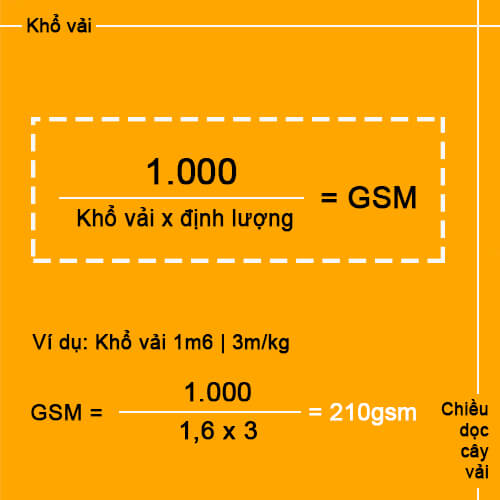How to calculate gram weight per meter GSM
Nhanh GSM đơn giản. Nếu bạn có khổ vải dài và chiều dài (mét) của 1 kg vải, thì tính nhanh theo công thức dưới đây:

Or versions like the steps below:
1/ Use a cloth cutter
Necessary tools:
Fabric GSM cutter
Digital Weighing Balance
Cutting pad
Method: Cut 5 fabric samples at different positions, accurately weigh the weight of each fabric sample, then calculate in the average gsm of the 5 fabric samples.
If it is a 113 mm diameter cutter, multiply the sample weight by 100 to get the gram weight of one square meter of fabric.
If the cutter diameter is 36 mm, multiply the sample weight by 1000 to get the gram weight of one square meter of fabric.
Use the calculation formula:
In the absence of a fabric cutter as above, we can also calculate the gram square meter weight of the fabric as follows:
Gram weight of fabric sample X 10,000 / Area of fabric sample in cm2
3/ Precisely cut the fabric area:
Cut 5 squares of fabric 10cm x 10cm
Accurately weigh these 5 fabric samples on an electronic scale
The average weight of these 5 fabric samples multiplied by 100 is the gsm weight of the fabric.
Determination of GSM weight of woven fabric based on fabric structure:
To determine the approximate GSM interval (grams per square meter) of a given fabric, you can use the following formula:
GSM = (EPI number /warp count + PPI /weft count ) x (100 + % bend) X 0.2327
In there:
EPI (End per inch): Warp density per inch.
PPI (Pick per inch): Weft density per inch.
% bend : The percentage difference between the length of the straight yarn and the length of the yarn in the state of the inside of the fabric.
For example, fabric structure is 40 X40 / 120 X 60 and warp and weft bending is 6%, then the GSM of this fabric can be calculated:
GSM = (120/40 + 60/40) X (100 + 6%) X 0.2327
GSM = 104.27
What is yarn bending rate in fabric (Crimp%)?
We know that woven fabrics are made of two yarn systems – warp and weft. The warp and weft threads are interlaced with each other and form the fabric. Inside the fabric, the yarns are always wavy instead of straight because the weft and warp threads always have to knit together. As a result, the actual length of the weft is always longer than the gauge and the warp length is always longer than the length of the fabric. This situation is true for both warp and weft yarns in fabrics. Shortening of yarn length in fabric is caused by bending of yarn. This degree of shortening is called the bending ratio
The percentage of yarn bending in a woven fabric structure varies depending on the fabric structure – like yarn density and yarn thickness.
How to calculate warp and weft bend ratio in fabric (Warp/Weft Crimp%:)
Use the following steps to find the crimp% of warp and weft.
Sample fabric 1 meter X 1 meter
Draw the warp and weft yarns one at a time from the fabric sample to full length.
Straighten each strand to its true length
Measure the length of the warp and weft. Suppose you have straightened and the length of the warp is 1.05 meters and the length of the weft is 1.08 meters.
Then calculate the curl percentage (crimp%) of the yarn using the following formula.
% Bending yarn = 100 X (B -A) / A
Where: B is the length of the straightened yarn
A is length of yarn in fabric
% warp crimp (Warp Crimp%) = 100 X [(length of warp in straight – length of warp pattern in fabric ) / fabric sample length]
% weft bend % (Weft Crimp%) = 100 X [(length of weft in straight form – length of weft in fabric ) / fabric sample length ]
From the above information we have:
% warp = ((1.05-1.00)/1.00) * 100 = 5%
% weft = ((1.08 -1.00) /1.00) * 100 = 8%
After having the bending ratio of the yarn in the fabric structure, in case the warp and weft bending ratios are the same, the approximate weight of the fabric can be calculated based on the formula as given above.
Another formula also allows the calculation of the approximate average gsm weight of the woven fabric where the bend angles of the warp and weft of the fabric are different. For example
GSM = ((EPI / warp count x 1.05) + (PPI / weft count x 1.08)) x 23.5
Cases 1.05 and 1.08 are warp and weft bending coefficients (length of straightened yarn/ length of yarn in fabric.
Whereby :
GSM = ((120/40*1.05)+(60/40*1.08))*23.5
GSM = 112 grams.
Note: The above formulas are for reference on the internet and the writer is completely untested. Only mentioned for your reference as to better understand the fabric. If there are testing conditions, feedback or adjust the formula for everyone to be clear.
In general, the most popular and recognized method is the method of using a circular fabric cutter as mentioned above, because it is both cheap and fast, and the results are the most accurate.
